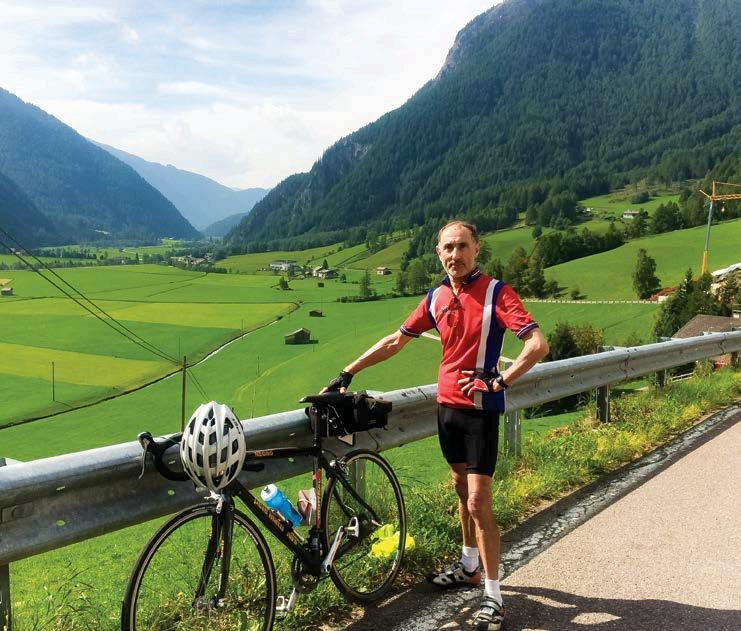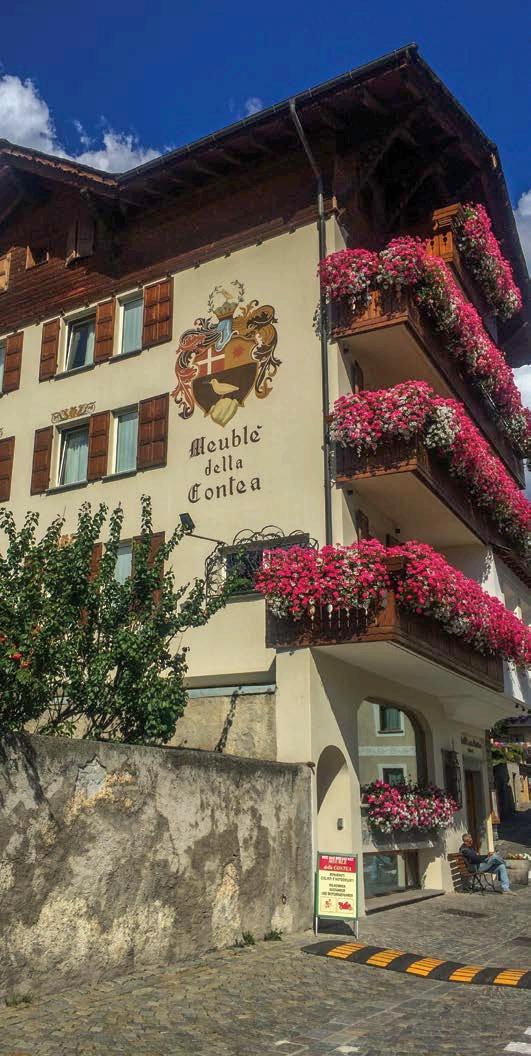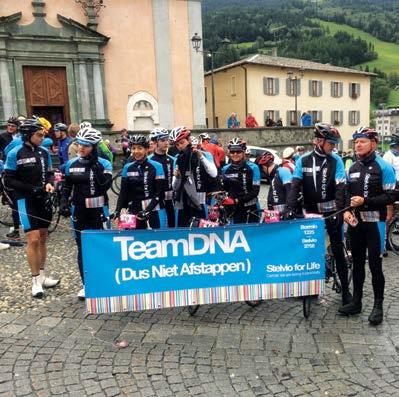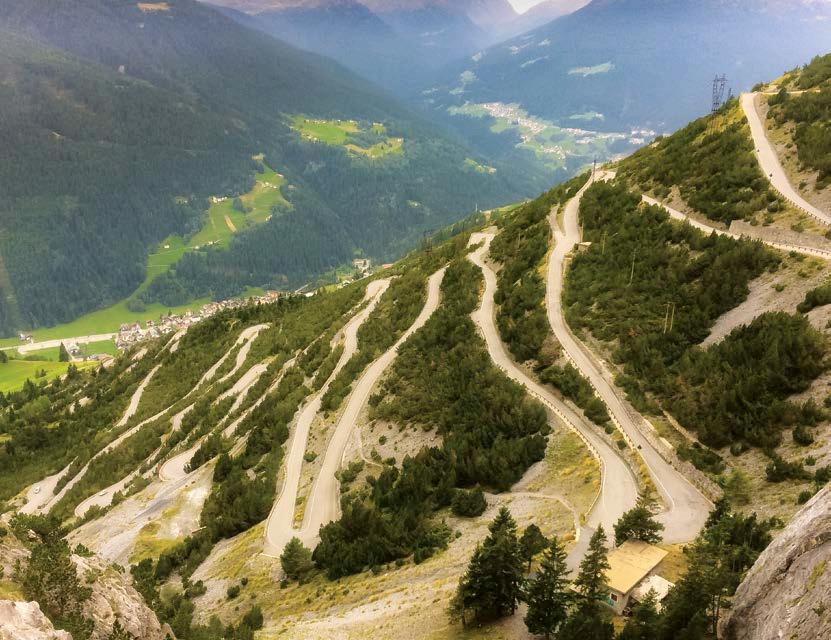
9 minute read
A tale of three tours
A trip to Northern Italy gave Pete Walden an idea for a tour of the Italian Alps. That was in 2014, and he’s now just back from his third tour of the region. What keeps him going back?
In May of 2014 my wife, Suzie, and I spent some time in Verona before setting off by train to Brescia and changing trains for the little line up the east side of Lake Iseo to Pisogne on the northern tip of this lake. During the next three days, we spent a day criss-crossing the Lake for seven euros each on a day rover, visiting most of the idyllic villages, and travelled by train up Val Camonica to the terminus at Edolo, within striking distance of some of the major passes in the Italian Alps. Our hotel in Pisogne had a battered old mountain bike for hire, and in spite of a slow front wheel puncture, I was able to crawl up the amazing switchbacks above the village, with ever more startling views of Lake Iseo, the unsung gem of Italy’s great lakes.
Advertisement
Back home, on discovering the nearness of Bergamo airport, bike tour planning instantly began, and sifting through the usual options, I decided not to hire a car, but to travel ultra light, and prebook an 11-day tour, staying two nights at only two places. This formed tour number one.
In 2016, tour number two differed in being clockwise and going further north-east nearing the Italian/Austrian border at Vipiteno, returning via the northern tip of Lake Garda.
Tour number three, just completed, went directly to Bormio, where I stayed for five nights, giving more opportunities for riding an unladen bike, and returned for two nights in Pisogne. This whole region has become, for me, one of which I don’t seem to tire, with endless nooks and crannies of discovery.
The common factors of all three tours are: tough, but manageable long climbs – for example the passes of the Stelvio, Bernina, Croce Domine, Maniva, etc – and the consistently warm welcome by the Italians. “Complimenti!” is the usual reaction when you explain which passes you’ve crossed to arrive at the guest house, instead of the incomprehension which often surfaces in our own country. Maybe my carbon Dedaccai frame built in Milan, or the pair of Pete Matthews’ Piani wheels, are also helpful. Also “Puo mettere la tua bicicletta in camera”, (you can put your bike in the bedroom) was not uncommon. The contrast of sunny lakeside roads and freezing descents presented a terrific variety of views, and the changes of weather made a selection of what to take in a small saddlebag, the Carradice Super C, crucial.
Logistics abruptly failed at the beginning of tour number one, when I had planned to assemble the bike from its flight bag on the airport concourse, leaving the bag in left luggage until my return. Late July found the small Bergamo Seria Airport mobbed, so plan B was to do all this outside. However, a torrential storm (wettest July in 20 years!) led to plan C, and an expensive taxi ride for me and the bike bag to the unique “Due Sili” Guest House, about seven kilometres away.
I rectified this situation on tours two and three by taking the bus into Bergamo
directly from the airport. €2.40 for me, and €2.40 for the bike in its bag saw me 20 minutes later outside any hotel in town, where I could assemble the bike at leisure, and leave the bike bag there after staying the night; collecting the bag after staying a further night at the end of the tour. Tours two and three were in early September, with more settled weather, and with the roads out of Bergamo noticeably quieter. My route choice was, on tour one, to get an overview of the area, and incorporate as many of the classic climbs as possible, on tour two, to explore more of the north-east area which, 100 years ago, was in Austria, and on tour three, to investigate some of the smaller valleys and villages around Bormio. This last idea was triggered by Giovanni, proprietor of the Meuble della Contea hotel in Bormio, after staying there for two nights in 2014 and one night in 2016, when he said, “Why not stay here for longer next year?” Giovanni is an Italian Mountain Guide who’s lived in

Bormio all his life, and remembers 1988, when Andy Hamsten won a Giro stage coming down the Gavia in the snow. “The best bit of cycling I’ve ever seen”, said Giovanni.
The whole region seems equally attractive for roadies and mountain bikers, as I discovered at the Giordano Hotel in Breno in 2014. I had just arrived, dutifully removed my cycling shoes, and tiptoed up the marble stairs to the bike room on the first floor, carefully placing my bike in a corner. As I left the room, about 12 mud soaked mountain bikers click-clacked up the stairs, and began flinging their muddy bikes around the walls. I ran back and retrieved my bike. “We’re in a group you know”, said one of them. “Ah yes”, I agreed, finding another neutral corner for my bike, and arranging chairs around it. The group must have found the only night life in little Breno, because much shouting and door slamming was heard at 2am.
The weather in 2014 was, at best, variable, and having slogged up the Gavia Pass from Ponte di Legno on a dull morning, I rested in the Refugio atop and fortified with Cioccolato Caldo. The descent with its fabulous views went fine to Santa Caterina, so much so that I pressed on towards Bormio, and that night’s hotel. Within seconds stair rods of
You can find Lake Iseo, in Lombardy, northern Italy, between the larger and more famous Lake Garda and Lake Como
❞
The Meuble Della Contea guest house

freezing rain were falling, and visibility shrank. By San Antonio with its cobbles and narrow streets, I could see nothing and feel no hands, so took refuge in a tiny bar. Down in Bormio the sun was out and the roads dry. Giovanni knowingly said, “Il Passo di Gavia, si”. We both laughed.
From Pisogne in 2014, I rode to Lovere, up to Clusone and followed the Seria valley to Valbondione, where, from the gelateria I studied the towering walls of the Alpi Orobie, reminding myself that the Aprica Pass was just the other side of these mountains. Was I up there only yesterday? My first day leaving Bergamo in 2016 saw busy traffic north to San Pellegrino, but much quieter conditions up the valley to scale the bleak 1985m San Marco Pass. From Morbegno the Valtelina east has a busy main road, so a continuous search for minor roads and bike paths is essential. I became hopelessly lost near Albosaggia searching for the Campelli Hotel. Asking the hotel’s whereabouts from two elderly folk in a parked car, I was told to follow them as they drove slowly there, which I did, through a maze of tiny roads. Outside the Hotel, they insisted on introducing me as Signore Walden who had arrived from over the San Marco Pass. “Complimenti!” said the proprietor.
After Bormio and the ascent of the south side of the Stelvio, the way down Val Venosta and entry into Merano in a maze of cycle paths was similarly tricky.
My three nights in Vipiteno included a ride up and down the beautiful Vizze valley close to the Austrian border, and a train trip to the quaint village of Brenero right on the Pass.
The other most vivid memory from 2016 came on the day from Riva del Garda to Iseo town. I failed to find the back way for bikes out of Riva, and instead mistakenly entered the 3.4 kilometre long tunnel across to the road for Mezzolago and Lake Ledro. With my rear light defiantly flashing, and myself taking frequent refuge in the works’ lay-bys, this was a truly horrendous experience, mainly because of the noise of the heavy lorries. All this was counteracted by the ascent of the Passo di Maniva to gain the head of the Val di Trompia. I’d say that this pass would be my favourite, as in 2017 I climbed it from the other side. The contrast in weather systems, facing either east or west is startling.
And so to this year. Thinks: “Yes, let’s get straight from Bergamo to Bormio. It’s only 160km, with the one major pass.” The S42 main road out to Bergamo turned out pleasantly traffic free, with Lake Endine glistening, before a spectacular drop in the heat to Lovere on lake Iseo. I negotiated the
gentle if long climb up to Edolo where I took a lunch break, before embarking on the start of the Tonale Pass, and soon took a sharp left turn for the “easy” side of the Mortirolo Pass. Mistake! A temperature of 30 degrees, a loaded bike and overgearing led to a crawl and four stops to reduce the pounding of my poor old heart. By the time I had made the tortuous descent into the valley and begun the slog to Bormio, the light was deteriorating. However, a 6.50 arrival was good enough. Giovanni at the
Dutch DNA cycling team
Meuble Della Contea hotel said “Il Passo di Mortirolo, si”. We both laughed.
Two more highlights followed. The first was meeting and having lunch with the “DNA Team” of Dutch cyclists atop the staggering ”staircase of Fraele” hairpin road, in the restaurant at the start of the unmade road around the high level lakes. This team was due to ride the Stelvio two days later on a Dutch-organised event for a cancer charity called “Stelvio for Life.”
Finally, from Pisogne, I rode up the St Zeno pass, with its horrible surface, then turned left and climbed up the Val di Trompia to the top of the Maniva Pass. A sign said,
“Passo di Croce Domimi Aperto”. So there followed further climbing with unimaginable
views, a section
of unmade road, two fabulous lakes and the beginning of a descent on smooth tarmac. All seemed well. There were still about 5km to the Croce Domini when the tarmac abruptly ran out, and, having gone well past the point of no return for the day, I had no choice but to continue on this appalling surface in spite of many motor bikes and 4x4s hurtling past in clouds of dust, until, thanking providence, I saw the café on Croce Domimi. I was very lucky that neither frame nor wheels were seriously damaged. Thanks, Pete Matthews, as the Piani wheels, now 11 years old, are still perfectly true.
Next year? Well, all three ways up the Mortirolo need attention, (a cog or 4 more), and maybe a jaunt into St Moritz over the Bernina Pass.
Last week I was changing the locks on our U.P.V.C. doors. I collected the new locks from the hardware store, and read on the packaging, “Made in Italy.” The brand name was “ISEO”. It’s a very small world!

❝… one of the highlights was meeting and having lunch with the DNA Team of Dutch cyclists atop the staggering Staircase of Fraele hairpin road
❞

Looking down on the staggering Staircase of Fraele road







